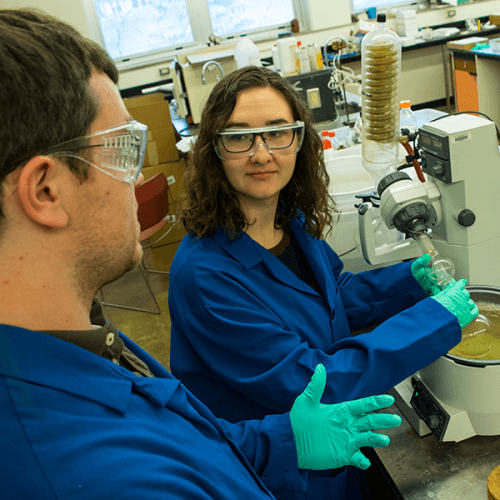Sarah Anderson ’10 honored as ESA Early Career Fellow
Posted June 25, 2025

“These have never been seen before by nature — they’re brand-new compositions,” says Assistant Professor of Chemistry Patrick Willoughby of recent molecule work at Ripon College.
Since 2013, Willoughby has worked with chemistry students, facilitating their research creating organic molecules. These molecules can be used as building blocks for a broad number of things, including pharmaceuticals or agricultural materials. Students are offered a paid summer position on campus to assist Willoughby in discovering and recording new ways to synthesize organic molecules. The research offers students the ability to conduct research on campus while being funded by grants.
The general goal for each student is to learn how to synthesize a molecule in different environments, using various methods. This summer, Willoughby worked with Amber Haugen ’19 of St. Cloud, Minnesota, who is studying off-campus in Amsterdam during the fall semester; and Rylie Morris ’19 of Dousman, Wisconsin. Morris, in her second year of working with Willoughby, studied new ways to develop a new class of catalysts used in organic synthesis to separate chiral molecules. These catalysts were once difficult to create, but Morris was able to revise and improve the procedure.
Haugen’s research focused mostly on aryne relay reactions, which allow one to create more complicated molecules. “More importantly, though, we were looking for an easier way to form complex organic compounds which could then be used as the backbone or basis of various pharmaceuticals,” she says.
Haugen also was able to create a phospho-molecule, a molecule that can be used agriculture or medical science, using a never before done reaction.
While the synthesis of new molecules is the main goal, seeing his students grow as chemists is what Willoughby enjoys about the project. “It’s really rewarding to see students take on a project at the beginning, and watch them grow from there,” he says. “When they start, they really need me to get them through all aspects; but by the end they’ve developed such a level of expertise that we just have a simple conversation and they can go into the lab and do everything themselves. It’s really fulfilling for both of us because the students get more autonomy doing the projects, and I can think about bigger aspects of the projects, ultimately the science is a lot faster.”
Haugen adds, “Being able to work with someone as knowledgeable as Dr. Willoughby one-on-one was a truly incredible experience. I feel I learned so much more in my summer with him than I could through any laboratory course in college.”
Marshall Sohr ’18
Oshkosh, Wisconsin
(Photo: Patrick Willoughby, left, and Rylie Morris)